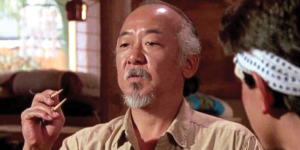Mr. Miyagi (Character): Difference between revisions
mNo edit summary |
mNo edit summary |
||
| (2 intermediate revisions by the same user not shown) | |||
| Line 6: | Line 6: | ||
Mr. Miyagi was inducted into the Fictitious Athlete Hall of Fame in 2015 in the Contributor Category. | Mr. Miyagi was inducted into the Fictitious Athlete Hall of Fame in 2015 in the Contributor Category. | ||
This is included in a collection of wiki entries referenced in the canonical Gen X Nikkei thought-piece [[101 Ways to Tell You’re Japanese American]] by [[Tony Osumi]] and [[Jenni Kuida]], published in 1996. | |||
[[Category:🇺🇸🇯🇵]] | [[Category:🇺🇸🇯🇵]] | ||
| Line 14: | Line 17: | ||
[[Category: The 1980s]] | [[Category: The 1980s]] | ||
[[Category: Needs Love]] | [[Category: Needs Love]] | ||
[[Category: 101 Ways]] | |||
[[Category: LA Nikkei]] | |||
[[Category: All Asians Know Martial Arts]] | |||
Latest revision as of 20:30, 10 January 2023

Mr. Miyagi is a fictional karate master from Okinawa, Japan in The Karate Kid film series. Mr. Miyagi mentors Daniel LaRusso and Julie Pierce in the films. Miyagi was played by Pat Morita, who earned an Academy Award nomination for Best Supporting Actor for his performance in The Karate Kid.
Mr. Miyagi's given name is inconsistent in the series. In The Karate Kid, the name Hideo Miyagi, which translates to “hero” Miyagi and is the real given name of Pat Morita’s brother, can be seen stamped in reverse on his World War II dog tags, being used as a keychain for the car he gives Daniel as a birthday present. As written in Japanese characters in The Karate Kid Part II, his name is 宮城成義 (Miyagi Nariyoshi), which translates as Nariyoshi Miyagi, which is also seen on his gravestone in Cobra Kai. He is called Keisuke Miyagi at the start of The Next Karate Kid.
Mr. Miyagi was inducted into the Fictitious Athlete Hall of Fame in 2015 in the Contributor Category.
This is included in a collection of wiki entries referenced in the canonical Gen X Nikkei thought-piece 101 Ways to Tell You’re Japanese American by Tony Osumi and Jenni Kuida, published in 1996.